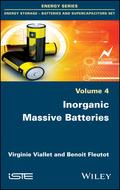Inorganic Massive Batteries

1. Edition March 2018
208 Pages, Hardcover
Wiley & Sons Ltd
Since the 90s, the Li-ion batteries are the most commonly used energy storage systems. The demand for performance and safety is constantly growing, current commercial batteries based liquid electrolytes or gels may not be able to meet the needs of emerging applications such as for electric and hybrid vehicles and renewable energy storage , and it is therefore necessary to develop advanced storage systems with characteristics such that the highest density of energy technology, long life, low cost of production, little or no maintenance and high safety of use. Batteries "all solid" are a technology of choice to meet these requirements. In this technology, the electrolyte separator between the two electrodes is no longer a liquid medium but a solid.
Chapter 1 Anatomy of an All-Solid-State Battery 1
1.1 Constituents of an all-solid battery 3
1.1.1 Nature of solid electrolytes: required qualities 3
1.1.2 Positive electrode materials 4
1.1.3 Negative electrode materials 5
1.1.4 Conductive additive 7
1.1.5 Formulation of electrodes 7
1.2 Shaping methods of all-solid batteries 8
1.2.1 Assembly by cold pressing 8
1.2.2 Design by high temperature sintering 10
Chapter 2 Solid Ionic Conductors 13
2.1 Introduction 13
2.2 Solid lithium-ion conductors 15
2.2.1 The Garnets 15
2.2.2 The NASICON AxMM'(XO4)3 Structure 17
2.2.3 The compounds LISICON and Thio-LISICON 18
2.2.4 Ion conductive glass and glass-ceramics 23
2.2.5 The Argyrodites 29
2.2.6 The complex hydrides 34
2.2.7 Phosphorus and lithium oxynitride or LiPON 36
2.2.8 Anti-perovskite lithium-rich solid electrolytes 36
2.2.9 Solid polymer electrolytes 39
2.3 Solid sodium-ion conductors 40
2.3.1 NASICON compounds 41
2.3.2 Na3PS4 42
Chapter 3 All-Solid-State Battery Technology Using Solid Sulfide Electrolytes 47
3.1 Monolithic Li-ion "all-solid-state" batteries 47
3.1.1 The first "all-solid-state" batteries 47
3.1.2 Second generation "all-solid-state" batteries 48
3.1.3 Toward High Performance Batteries 53
3.1.4 Batteries using lithium argyrodite electrolytes 58
3.1.5 Li10XP2S12 (X = Ge, Si, Sn) phase in the structure LGPS 66
3.1.6 Understanding stability at the interfaces between the electrolyte and electrode materials 81
3.1.7 Summary 84
3.2 Sodium monolithic "all-solid-state" batteries 85
3.3 "All-solid-state" Li-S batteries 91
Chapter 4 Monolithic "All-Solid-State" Batteries Using Solid Oxide Electrolytes 97
4.1 Silver "all-solid-state" battery technology 97
4.2 Li-ion "solid-state" battery technology 100
4.3 Sodium "solid-state" battery technology 108
4.3.1 Sodium-ion "solid-state" battery technology 108
4.3.2 Sodium-sulfur "all-solid-state" battery technology 116
Chapter 5 LiBH4 Electrolyte and Polymer Battery Technology 119
5.1 "All-solid-state" battery technology: LiBH4 electrolyte 119
5.2 "Solid-state" polymer battery technology 120
Chapter 6 Markets 123
6.1 Solid electrolytes 123
6.1.1 Ohara 123
6.1.2 NEI 127
6.2 Solid-state batteries 127
6.3 Conclusion 137
Conclusion 139
Bibliography 145
Index 167
BOUCHET Renaud,? Professor, CNRS, Grenoble Alpes University.
DOLLE Mickaël, Associate Professor, Department of Chemistry, University of Montreal.


